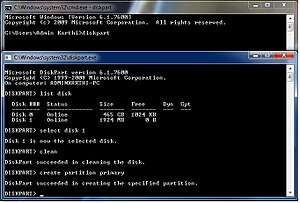diskpart
In computing, diskpart is a command-line disk partitioning utility included in Windows 2000 and later Microsoft operating systems, replacing its predecessor, fdisk.[1][2] The command is also available in ReactOS.[3]
 | |
| Developer(s) | Microsoft, Lee Schroeder |
|---|---|
| Initial release | February 17, 2000 |
| Operating system | Windows, ReactOS |
| Predecessor | fdisk |
| Type | Command |
| License | Windows: Proprietary commercial software ReactOS: GPLv2 |
| Website | docs |

diskpart commandOverview
The diskpart is a utility used for partitioning internal hard drives but can not format removable media such as flash drives.[4]
Although theoretically it is possible to create in Windows NT 4.0 / 2000 / XP on removable flash drives such as flash drives or memory cards for example during system installation. However, the ability to format, for example, the Recovery Console, is completely blocked to format such a disk. A message will appear: 'Cannot format removable disk'. Microsoft noticed this error. And it completely blocked the ability to view and create partitions from Windows Vista to Windows 10.
The command supports the use of scripts to automate its usage. For example, the following text file could be supplied to diskpart to create a new partition:
create partition logical size=2048 assign letter=F
This will create a 2 GB logical partition at the beginning of the free space on the disk and assign it the drive letter F:, provided that space requirements are met.[5]
The installed disks and their associated volumes and/or partitions can be viewed by these commands:
list disk list volume list partition
The ReactOS version was developed by Lee Schroeder and is licensed under the GPLv2.[6]
Recovery Console
On the Recovery Console, which is included in all Windows 2000, Windows XP and Windows Server 2003, there is a diskpart command which is significantly different from the one included in the actual operating system. It only provides functionality for adding and deleting partitions, but not for setting an active partition.[7]
See also
References
Footnotes
- "DiskPart". Windows XP Command-line reference A-Z. Microsoft. Retrieved 3 April 2015.
- "How to extend a data volume in Windows Server 2003, in Windows XP, in Windows 2000, and in Windows Server 2008". Support. Microsoft. 11 September 2011.
- https://github.com/reactos/reactos/tree/master/base/system/diskpart
- "DiskPart Commands". Windows Server 2008 R2 and Windows Server 2008 Command-Line Reference. Microsoft. Retrieved 3 April 2015.
- Bhardwaj, Pawan K.; Andreou, Kimon; Barber, Brian; Kleiman, Dave; Satyanarayana, Mahesh (2006). How to cheat at Windows System Administration using command line scripts. Rockland, MA: Syngress. ISBN 1-59749-105-5.
- https://github.com/reactos/reactos/blob/master/base/system/diskpart/diskpart.c
- "Description of the Windows XP Recovery Console for advanced users". Support. Microsoft. 11 July 2013.
Citations
- "Appendix: Tools and APIs for Virtual Hard Disks". Getting Started with Virtual Hard Disks. Microsoft. 15 October 2010. Tools used to maintain VHD images.
- Tulloch, Mitch; Northrup, Tony; Honeycutt, Jerry; Wilson, Ed. "Create and Use a Virtual Hard Disk on Windows 7". TechNet Magazine. Microsoft.
- "Walkthrough: Deploy a Virtual Hard Disk for Native Boot". Windows Automated Installation Kit for Windows 7. Microsoft. Retrieved 3 April 2015.
- "Add a Native-Boot Virtual Hard Disk to the Boot Menu". Windows Automated Installation Kit for Windows 7. Microsoft. Retrieved 3 April 2015.
- Brink, Shawn (26 Jan 2009). "Virtual Hard Drive VHD File - Create and Start with at Boot". Windows 7 Forums. Retrieved 3 April 2015.
Further reading
- Frisch, Æleen (2001). Windows 2000 Commands Pocket Reference. O'Reilly. ISBN 978-0-596-00148-3.
- John Paul Mueller (2007). Windows Administration at the Command Line for Windows Vista, Windows 2003, Windows XP, and Windows 2000. John Wiley & Sons. ISBN 978-0470165799.
External links
| Wikibooks has a book on the topic of: Guide to Windows Commands |
- "DiskPart commands". Windows Server/Windows Commands/Commands by Server Role. Microsoft. Retrieved 22 January 2020.
- "DiskPart.exe and managing Virtual Hard Disks (VHDs) in Windows 7". GES on Windows 7. Microsoft. 8 October 2009.